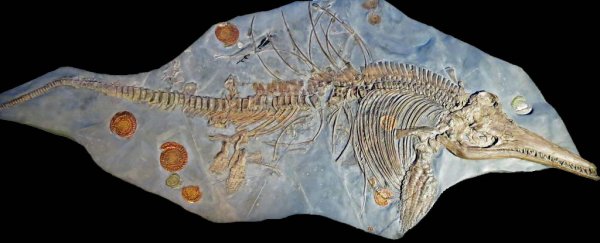Palaeontologists have identified the largest 'sea dragon' of its kind in the fossil record, after discovering the mislabelled remains of an ancient ocean dweller from 200 million years ago.
The specimen, the largest representative of the Ichthyosaurus genus on record, was a kind of marine reptile commonly taken to be a swimming dinosaur – but which actually emerged 250 million years back, before the dinosaurs reigned.
The newly identified Ichthyosaurus somersetensis – one of six species in the Ichthyosaurus genus – was originally discovered on the Somerset coast in the UK during the 1990s, before eventually ending up on display in the Lower Saxony State Museum in Hannover, Germany.
But it wasn't until palaeontologist Sven Sachs from Germany's Bielefeld Natural History Museum examined the display while working on other marine research that he realised the uniqueness of the individual.
"I found it very extraordinary," he told Sarah Gibbens at National Geographic. "[It was] way bigger than any specimen I had examined."
 Dean R. Lomax
Dean R. Lomax
Calling in colleague Dean Lomax from the University of Manchester in the UK, the pair investigated the specimen and found it was indeed a large I. somersetensis – an Ichthyosaurus species Lomax had helped to originally discover.
It's perhaps no great surprise that the specimen's custodians hadn't pegged their 'sea dragon' down exactly – after all, I. somersetensis was only first identified in research published last year.
But it's another reminder of how museums and private collections sometimes possess unidentified specimens that are actually valuable additions to the scientific record once they've had a chance to be studied.
"It amazes me that specimens such as this can still be 'rediscovered' in museum collections," says Lomax.
"You don't necessarily have to go out in the field to make a new discovery."
 Joschua Knüppe
Joschua Knüppe
Apart from the individual's significant size – estimated to have been between 3 to 3.5 metres long (9.8 to 11.5 ft) when fully extended – the female was also notable for something else: she was pregnant when she died.
Analysis of the mother's fossil revealed the presence of an incomplete embryo preserved inside her for around 200 million years, including a portion of the back bone, a forefin, ribs, and a few other bones.
"Although there are certain kinds of ichthyosaurs which are known to have a lot of embryos, there are certain genera that hardly have any embryos preserved, and Ichthyosaurus is one of them," Sach explained to Becky Ferriera at Motherboard.
That makes the find an important discovery for scientists, and it's one that suggests something we previously didn't know.
Specifically, this is the third Ichthyosaurus fossil that's been found showing evidence of a pregnant female – and all three of these specimens have only contained one embryo each.
"The preliminary conclusion is that Ichthyosaurus, as a more basal genus, compared with later genera that had higher numbers of embryos, may only have had one embryo," Sachs told Motherboard.
Of course, it's only a hypothesis for now based on the limited fossil evidence available, but if that trend gets borne out by future discoveries, the insight would be "new to science", Sachs thinks.
Another factor that obscured the specimen's true lineage was its tail – or, rather, the addition of a fake, cosmetic tail.
For display purposes, the museum had kitted the fossil out with a tail from another ichthyosaur, to help complete its Jurassic showpiece and provide a more aesthetically pleasing exhibit.
That might be okay for casual observers in a museum setting, but it's the kind of practice that can also do more harm than good in the long run in terms of scientific understanding.
"Sometimes, as in this instance, specimens aren't exactly what they appear to be," Sachs explains in a press release.
"[I]f 'fake' portions remain undetected then scientists can fall foul to this, which results in false information presented in the published record."
Luckily, in this case, some keen paleontologist eyes discerned the fakery – and those powers of observation helped to fill out the scientific record for everyone's benefit.
Next time you're headed to the museum, you'd do well to be on the lookout too.
The findings are reported in Acta Palaeontologica Polonica.
